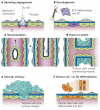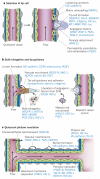Molecular mechanisms and clinical applications of angiogenesis
- PMID: 21593862
- PMCID: PMC4049445
- DOI: 10.1038/nature10144
Molecular mechanisms and clinical applications of angiogenesis
Abstract
Blood vessels deliver oxygen and nutrients to every part of the body, but also nourish diseases such as cancer. Over the past decade, our understanding of the molecular mechanisms of angiogenesis (blood vessel growth) has increased at an explosive rate and has led to the approval of anti-angiogenic drugs for cancer and eye diseases. So far, hundreds of thousands of patients have benefited from blockers of the angiogenic protein vascular endothelial growth factor, but limited efficacy and resistance remain outstanding problems. Recent preclinical and clinical studies have shown new molecular targets and principles, which may provide avenues for improving the therapeutic benefit from anti-angiogenic strategies.
Figures



References
-
- Folkman J. Angiogenesis: an organizing principle for drug discovery? Nature Rev. Drug Discov. 2007;6:273–286. - PubMed
-
- Carmeliet P. Angiogenesis in health and disease. Nature Med. 2003;9:653–660. - PubMed
-
- Swift MR, Weinstein BM. Arterial–venous specification during development. Circ. Res. 2009;104:576–588. - PubMed
-
- Wang R, et al. Glioblastoma stem-like cells give rise to tumour endothelium. Nature. 2010;468:829–833. - PubMed
Publication types
MeSH terms
Substances
Grants and funding
LinkOut - more resources
Full Text Sources
Other Literature Sources
Medical
Miscellaneous

